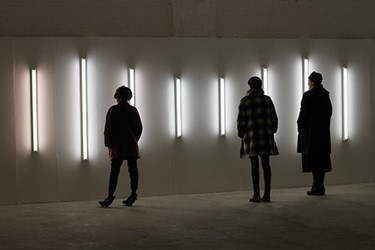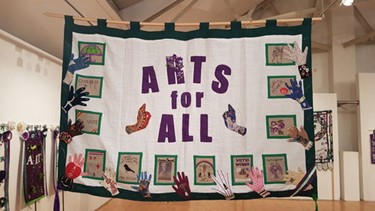Opening: Friday 2 February, 7-9pm
Continues: 3 February – 28 March 2018
Artist Talk: Saturday 17 February, 12-1pm
Artist Master class: 24 February, 10-4pm
Components of the Scene
by Brian McAvera
In 1966 the writer Ronald Blythe published an anthology of stories, poems and essays on the Second World War called Components of the Scene. He was trying to give an overview of the war from the points of view of professional writers, but his title acknowledged that the individual component parts were capable of being re-assembled in many different ways, and therefore capable of creating many different ‘Scenes’.
You, the audience, are currently looking at an exhibition by Sinead McKeever called Antenna. Although it has a number of familiar component parts, such as the large charcoal drawings, it is not like an exhibition produced by, for example, a painter, in which every work has a life of its own and can be separated from every other work on the walls. With McKeever’s work it is the totality of the parts that is important, as she is creating an Installation which responds to the physical structure of the gallery, not only in terms of the length, breadth and height of its two main rooms (the walls and the floor) but also in terms of the complicated physical construction of its ceiling.
Unlike you, the reader, this writer, at the time of writing, has not seen the Installation because it has not yet been constructed. What he has seen are the component parts, charcoal drawings on the studio walls, sketchbook plans which may or may not be followed, smaller drawings and paintings on small pieces of dibond, and, made from the same substance, a sculptural installational piece, currently inhabiting the corridor outside of the studio, where, starting at the top of a doorframe, it bends and twists through space before diagonally thrusting downwards to the floor. So, if the component parts both actual, and probable (what the artist is intending to do), are outlined, in a very real sense you, the viewer, can peek over the artist’s shoulder and look at the creative process: you can observe how she has used the component parts, where she has put them, how she has adapted them to the physical aspects of the galleries and – if you think of the whole installation as being like a journey – how she controls the way in which you move through the galleries.
So, what is the plan? Well, as currently envisaged Gallery 2, the smaller space, will have six large charcoal drawings (H 1530mm x W 1220mm) as well as a number of smaller drawings and paintings which are on dibond. There will be a globe, mounted on an easel, but if you touch it you will get powder on your fingers. There is likely to be a pigment work, possibly also using dibond, which might start on the wall and then shift to the floor but if you walk through it, you will get powder on your shoes and leave footprints on the floor.
At this point you might think of the title: Antenna. In 1907, in Galway, Marconi created the first commercial, transatlantic radio signal connecting Europe and North America. So, we are in the world of communications. If you look at the charcoal drawings, there are circular elements (Globes? Satellites?) and very strong suggestions of outer space, perhaps of electrons or atoms whirring through. If you look closely at the small drawings you will find strips of transparent cellotape, suggestive of antennae, and of rays emanating from antennae.
Shift now into the main room, Room 1, with its complex ceiling structure. The artist started with eight sheets of dibond (H 2440mm x W 1220mm) and two sheets (H 3050mm x W 1250mm) of the same substance. Dibond is a shiny, reflective, aluminium composite made from two layers of the metal with a plastic centre in-between. McKeever cuts these sheets into strips, thinner ones between 23 and 25 mm and thicker ones between 58 and 62 mm, which she can bend and twist. She connects them with butterfly ‘wing’ nuts. As the wing nuts project outwards, they are nodal points for the attraction and reflection of light. The already-mentioned work that was in the corridor outside the artist’s studio will be in this room, and there will be at least one other similar piece, probably a mirror image of this one, though it might reside on the floor as opposed to coming off a wall. If it is on the floor, stand as close as possible and look directly downwards. Two things happen simultaneously: the ceiling is reflected in the strips, but projected onto the floor. It’s as if you are looking downwards into a pit.
You might also look at whether the artist has decided to heighten the perceptual oddities, and indeed the perpetual uncertainties, by using lighting. Will the dibond sculptural pieces be backlit for example? What kind of shadows are created? How are the reflections (including your own) utilised? You are not just walking around an exhibition: you are in it. It is immersive, and this might lead you to ask yourself about boundaries. Where does something start? Where does it encroach upon something else? Where does it finish? You are navigating the room, not just standing in the middle and observing the sequencing.
You might also ask yourself why the artist uses the somewhat unlikely material of dibond. It’s an industrial material with connotations of coolness and formality. But because of its reflective properties, which can be heightened by a careful use of lighting, at the moment we approach it we ourselves are now locked into its imagery. So, unless the artist has opted for second thoughts and introduced something unexpected, you are now in possession of all of the component parts: the globe, the charcoal drawings, the small drawings and paintings, the pigment piece, and the large dibond sculptural works. How has she put them together? How has she responded to the physical properties of the spaces? How has she decided to light each and every element? How has she used shadows? Why is there so little colour? How has she created a pathway through the installation for you to observe? One great thing about writing an essay before seeing the finished exhibition: I don’t have to answer the questions! But you can…..




